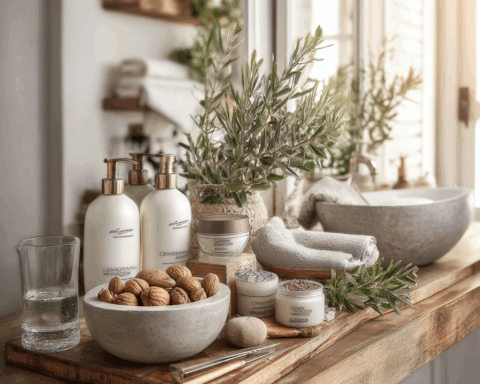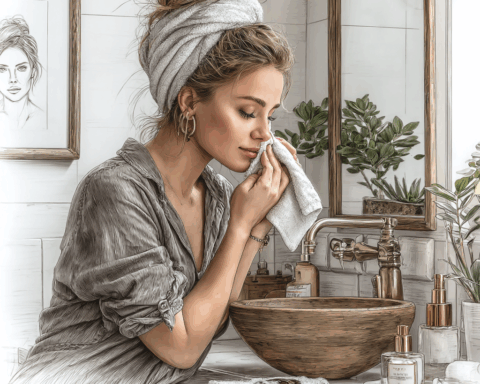Korean Skincare: A 10-Step System or Skin Overload?
Korean skincare has become a true beauty phenomenon, winning the hearts of millions of women around the world. However, as many transition to its 10-step system, they often wonder: is this truly necessary for us, considering our climate and the characteristics of Caucasian skin? Undoubtedly, each of us strives for the perfect complexion, but where is the line between intentional skincare and overload?
The Essence of the 10-Step System: Philosophy and Steps
The Korean skincare system is based on a multi-layered approach that emphasizes following specific steps, each serving its purpose: from makeup removal to sun protection. The first step is makeup removal, which can be done with cleansing oils or balms, essential for removing makeup and impurities. Next comes cleansing, where foams or gels are used to thoroughly cleanse the skin from leftover products and dirt.
Equally important is the exfoliation step, which helps eliminate dead skin cells and improves skin texture. Moving on to toning, we restore the skin’s pH level and hydrate it. At this stage, attention is given to the essence — a lightweight serum that infuses the skin with beneficial components.
This is followed by a serum or ampoule, which provides concentrated care; a sheet mask for quick hydration; and an eye cream, which takes care of the delicate area around the eyes. Finally, a moisturizer completes the ritual by “sealing” in moisture, while SPF protects against ultraviolet rays. Each step can be adapted according to age, skin type, and season, highlighting the flexibility of the Korean approach.
Advantages of Korean Skincare and Its Difference from European Practices
Korean products emphasize natural and innovative ingredients: enzymes, plant extracts, peptides, and hyaluronic acid. Unlike the Western approach, which often focuses on testing and treating existing issues, Korean skincare emphasizes prevention and maintaining skin health.
This system allows for deep hydration of the skin. Essences and serums provide multi-layered moisture, which is especially relevant in dry conditions. Regular hydration steps help restore and strengthen the skin’s barrier function, significantly reducing the risk of irritation and flakiness, especially in cold weather.
Arguments ‘For’: Proven Effectiveness of the Step-by-Step Korean Skincare
One of the key advantages of Korean skincare is the potential for customization. By working with various textures and active ingredients, you can tailor your skincare routine to your needs. For example, gel textures can be chosen for oily skin, while richer creams and oils are better for dry skin. Skincare becomes a pleasant ritual, which also positively impacts stress levels.
Arguments ‘Against’: Risks of Overload and Over-Care
Despite all the merits, it is essential to be aware of the risks associated with skin overload. Excessive use of active ingredients can lead to clogged pores, irritation, and sensitivity; therefore, it is crucial to avoid overindulgence in acids and peptides. Additionally, some ingredients may conflict with each other, which is also necessary to consider when developing your skincare routine.
For most types of Caucasian skin, it is advisable to stick to 3-5 steps — cleansing, toning, serum/cream, and SPF. This simplified system helps avoid withdrawal syndrome, where the skin may begin to look dull and dehydrated due to insufficient care.
Adapting Korean Practices to the Russian Climate and Caucasian Skin
Given the Russian climate, often characterized by a long cold season and temperature fluctuations, adapting Korean skincare is essential. Pay attention to cleansing: during winter, opt for gentle products rather than aggressive ones. Exfoliation should be done 1-2 times a week to avoid harming sensitive skin.
Toners and essences containing beta-glucan and centella can help your skin feel more comfortable during the heating season. Choose serums and creams according to skin type: gel-based for oily skin, nourishing for dry skin. Sheet masks can be conveniently used 1-2 times a week as an emergency remedy, and SPF usage should not be limited to just the summer months.
The Personal Experience and Perspective of a Plastic Surgeon
As a plastic surgeon, I often observe patients who, captivated by the trend of Korean skincare, face issues of excessive care — irritation and allergies. My advice: listen closely to your skin rather than chasing every new trend. It’s best to select 3-5 steps, but do so thoughtfully.
Preparing the skin before plastic surgery is also important. An overly “rich” skincare routine increases the risk of reactions during recovery, so I recommend pausing the use of active acids for two weeks before the procedure and switching to a gentle basic regimen. This way, your skin will be in the best condition for the upcoming procedure.
Combining Korean Skincare with Post-Surgery Care
During the recovery period, it is crucial to use only those products approved by your doctor. Typically, 2-3 weeks after surgery, you can start introducing light cleansing oils and essences, gradually transitioning to a Korean skincare routine. Products containing centella, allantoin, and madecassoside promote healing and can positively affect recovery.
Recommendations for Choosing Products and Frequency of Use
When selecting products, stick to a clear schedule. Daily cleansing with cleansing oil should be performed, as well as foaming cleansing. Exfoliation should be scheduled 1-2 times a week with care regarding acids. Toner and essence are perfect for daily application, while serums and creams can be used 1-2 times a day according to the skin’s needs.
Don’t forget about sheet masks, which can be used as needed, and eye creams that should be applied daily. The moisturizer should adapt to the season. SPF must be used daily, even in cloudy weather.
Conclusion: Should Caucasian Skin Embrace Korean Practices?
Korean skincare is not a rigid doctrine but rather an inspiring guideline. It’s essential to listen to your skin and understand that an abundance of products is not always the key to beauty. If your skin looks healthy, hydrated, and has a good barrier function, then you are on the right track. Korean skincare can be a great tool for improving skin condition, but it is important to remember personalization and avoid overload.
Adapting Korean practices to our climate and skin characteristics is the key to success. If you are planning plastic surgery, coordinate your skincare with your doctor. Well-prepared skin is the foundation for quick and beautiful recovery.
Korean skincare offers excellent opportunities for improving skin condition if approached wisely and without excessive overload. Each of us must find our path to beauty — it’s important that it be comfortable and individualized.
Do you want to keep up to date with the latest news about plastic surgery? Subscribe to my Telegram channel: https://t.me/By_Staisupov_ENG
Do you like to watch videos? More useful information is available here (the channel is in Russian, but you can always turn on auto-titles): https://www.youtube.com/@staisupov
All the results of plastic surgery can be found here: https://staisupov.com/results







